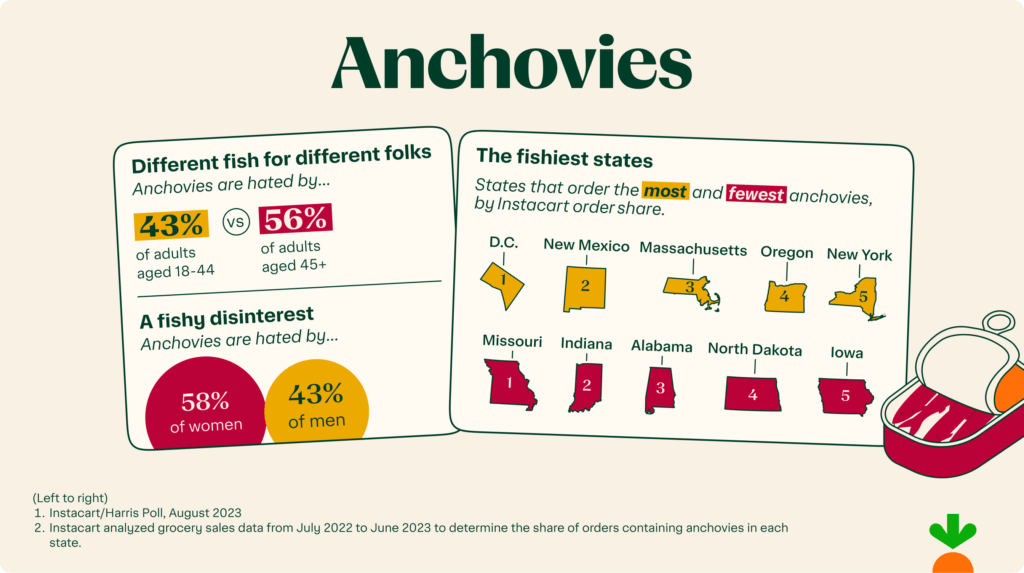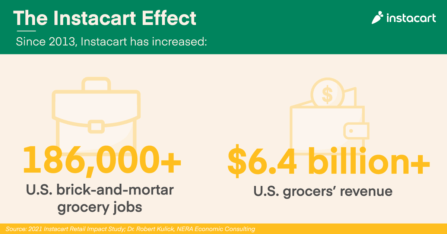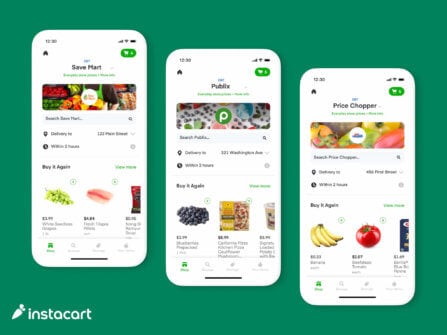Company Updates
Love It or Loathe It: Instacart Reveals America’s Most Polarizing Foods

Chances are there’s at least one food everyone tries to avoid on the dinner plate, at restaurants, or during family gatherings. But which foods do we collectively loathe at higher rates than others? From pungent seafood to tangy pickled bites, there’s a spectrum of foods that spark passionate debates among our taste buds, and some are more polarizing than others. Let’s take a look!
After researching some of the most divisive foods, we created a list of the top contenders and then commissioned a survey conducted online by The Harris Poll. Within the survey, we asked more than 2,000 Americans which of those foods they hated.
Here’s a breakdown of the most hated (sorry anchovies!) → least hated (you’re not so bad, mayo) polarizing foods:

“While the list of divisive foods is long, let’s focus on the top three hated foods – anchovies, black licorice, and oysters – and what makes each seemingly controversial for American palates. Anchovies possess a briny, fishy flavor profile, oysters give off a super slimy mouthfeel, and licorice shocks the tongue with an unmissable anise and fennel flavor. On top of that, they all present chewy textures that can prove challenging for certain people. The complex interplay of these unique flavors and textures is likely why they’re at the top of the list, and it’s also the reason we’re not seeing foods like white bread show up.” – Laurentia Romaniuk, Instacart’s Trends Expert
Let’s explore the top polarizing foods a bit more deeply…
Hold the Anchovies
Our survey found that half of Americans hate anchovies, making the small, oily fish the most hated polarizing food on our list. Below, we include a breakdown of the states that order the most and fewest anchovies by Instacart share order, in addition to a few other bite-sized insights.

Licorice’s Dark Secret
Following anchovies, 45% of Americans hate black licorice, according to our survey. This may not come as a surprise, but there’s a generational and gender divide when it comes to this candy – more below.

The World is Your Oyster
Are oysters an epicurean pleasure or a pass? Our survey found that 41% of Americans hate this delicacy from the sea, with 51% of women and only 30% of men giving it a hard pass. Curious indeed!
What’s also curious is that three of the five top states that order the most oysters are completely landlocked – Montana, North Dakota, and Wyoming – while three of the five states that order the fewest oysters are located in New England – New Hampshire, Vermont, and Maine – with much closer access to the ocean and a proclivity for consuming seafood.

Polarizing POV’s: additional findings from our survey found…
- The top reasons Americans think a food could be polarizing or controversial include:
- Smell – 66%
- Strong flavor – 57%
- Texture – 57%
- Visual appearance – 47%
- Type of flavor (e.g., sweet, sour, salty) – 47%
- How it makes you feel after eating it – 32%
- 37% of Americans have food preferences they consider to be polarizing or controversial.
- Nearly 7 in 10 Americans (69%) say they have encountered a food that they initially disliked but eventually grew to enjoy.
- 37% of Americans say they are eager to try new foods that have a polarizing or controversial reputation.
Whether you love ‘em or hate ‘em, we hope this provides some interesting food for thought next time you indulge in these controversial foods.
Survey Method:
This survey was conducted online within the United States by The Harris Poll on behalf of Instacart from August 3-7, 2023, among 2,032 adults ages 18 and older. The sampling precision of Harris online polls is measured by using a Bayesian credible interval. For this study, the sample data is accurate to within +/- 2.7 percentage points using a 95% confidence level. For complete survey methodology, including weighting variables and subgroup sample sizes, please contact [email protected].
Adjusted for Growth:
We adjust Instacart growth percentages by the overall growth of total orders via Instacart. Doing so removes the influence of our platform growth so we can focus on the change in consumer behavior.
Most Recent in Company Updates

Company Updates
Tackling Food Deserts in Columbia, SC: First Year Success and Program Expansion Plans
Many people across the country continue to face challenges accessing food because they live in food deserts – areas where affordable food options, including fresh fruits and vegetables, are hard to find. But we have…
Feb 3, 2025
Company Updates
Instacart Celebrates Its First-Ever Big Game Ad with Free Snacks with Your Order, Deals & Surprise Deliveries
Fans can get in on the action with a week of game day deals, free snacks with your order, and even a chance to get their Big Game Instacart order delivered by beloved grocery brand…
Jan 30, 2025
Company Updates
Ordering Groceries With an AI Agent, Like OpenAI’s Operator
Instacart Continues to Drive the Future of AI, Leaning Into Agentic Tools If you’ve ever wished someone else would order your groceries–and you’re an OpenAI ChatGPT Pro subscriber–you’re in luck. With the introduction of AI-powered…
Jan 23, 2025

 Instacart’s Impact on America’s Grocery Industry, by the Numbers
Instacart’s Impact on America’s Grocery Industry, by the Numbers  Breaking Down Barriers to Food Access with EBT SNAP Expansion
Breaking Down Barriers to Food Access with EBT SNAP Expansion  Beyond the Cart: A Year of Essential Stories
Beyond the Cart: A Year of Essential Stories  A Hot Take on America’s Favorite Hot Sauces 🌶
A Hot Take on America’s Favorite Hot Sauces 🌶  JuJu Smith-Schuster: What’s in my Cart?
JuJu Smith-Schuster: What’s in my Cart?  Introducing the First-Ever Instacart Emerging Brand List
Introducing the First-Ever Instacart Emerging Brand List 
